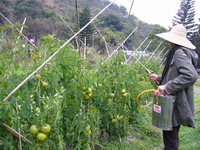
Food Safety Focus (19th Issue, February 2008) – Food Safety Platform
Pesticide Residues in Food (Part I)
Reported by Dr. John LUM, Scientific Officer,
Risk Assessment Section, Centre for Food Safety
From time to time, we hear different reports on pesticide residues in food and their adverse effects on human health. However, do we really KNOW pesticides? In the coming three issues, this column will have a closer look at pesticides – from their origins to safety evaluation and setting of permitted levels in food.
Many Things around Us are Pesticides
In broad sense, pesticide is any substance or mixture of substances intended for preventing, destroying, repelling or mitigating pest. Any living organisms that are not wanted because of their damage to crops or properties, or affect human or other animal health could be regarded as pests. Pesticides are commonly used to treat these pests and their presence is ubiquitous. Few people have not applied domestic pesticides such as cockroach sprays at home.
Some pesticides are specifically developed to control pests in food production, especially during crops growing. Classes of pesticides commonly used in crops growing include insecticides (to control insect infestations), fungicides (to control the spread of fungal diseases) and herbicides (to control the competing effects of weeds). In this article, we will focus on pesticides used in food production.
Illustration: Application of pesticides in crop production

A Brief History of Pesticides
As early as around 1000 BC, people have used different chemicals (e.g. sulphur) as pesticides. Advances in chemical science and the adoption of intensive farming practice have led to the development of more effective chemical pesticides. Chemical pesticides were, at one stage, championed as human's success over nature. But pesticide resistance, damage to the environment and adverse effects on human health have overshadowed their subsequent use. With more stringent control on pesticides, pesticides have apparently found their place in the agricultural system. Two important classes of chemical pesticides, organophosphate and organochlorine, with food safety concerns are detailed below:
- Organophosphate (OP) pesticides – OP pesticides are insecticides act by affecting the nervous system of insects through disrupting the neurotransmitter acetylcholine. Many OP pesticides are also acutely toxic to animals, mainly by affecting the nervous systems. Methamidophos, which has caused acute food-poisoning cases in human, is an OP pesticide. The use of methamidophos and many OP pesticides has been stopped in many countries due to their potential adverse effects in human.
- Organochlorine (OC) pesticides – One of the most well-known OC pesticides is DDT. DDT is a broad-spectrum insecticide invented in the 1940s and quickly became the most widely used pesticide in the world. However, DDT persists in the environment and was found to affect reproduction and development in a number of animal species in the 1960s. Since then, DDT was not permitted to be used in many countries.
Although most of the commonly used pesticides are synthetic chemicals, biopesticides have gained their popularity in recent years, as a result of increasing popularity for organic products. Biopesticides are pesticides derived from natural materials such as animals, plants and bacteria. The most well-known biopesticide comes from the bacteria Bacillus thuringiensis (Bt).
Pesticide Residues in Food – the Wrong Item in the Wrong Place?
The proper use of pesticides could improve the quantity and quality of food. The days that farmers found half of their crops being eaten up by worms might have been gone! However, the use of pesticides in food production would inevitably leave some residues in some of the products. Risk to human health could be reduced with proper usage of pesticides. Although most of the pesticides are used during crops growing (pre-harvest) , pesticides could also be applied during storage and transport of the crops (post-harvest). Moreover, food animals may accumulate pesticide residues in their body through the consumption of feed containing pesticide residues.
Pesticides that are not applied intentionally during food production may also cause residual problems. Some pesticides are persistent in the environment and traces of them may contaminate our food.
The next issue of Food Safety Platform will cover the safety of pesticides. Do not miss it!


